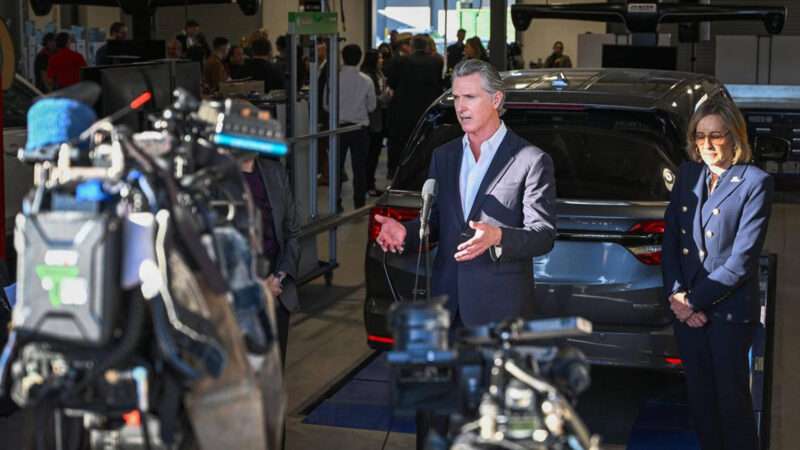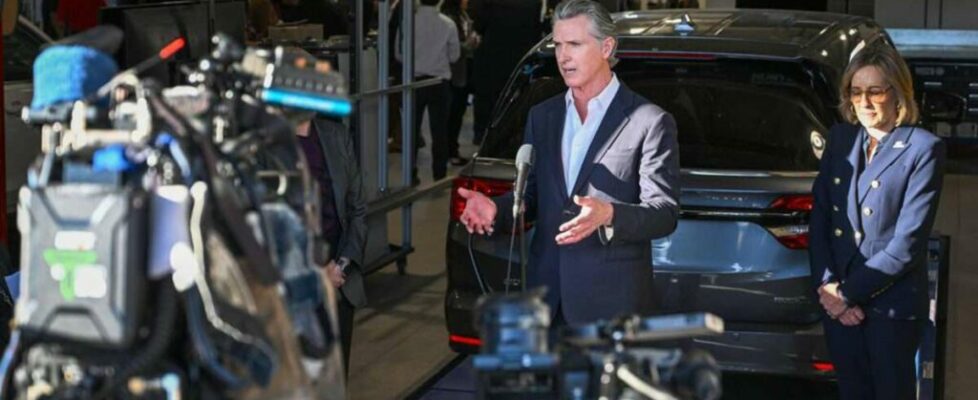Donald Trump Wants To End E.V. Subsidies. Gavin Newsom Is Trying To Save Them.

The incoming Trump administration is considering rolling back the $7,500 federal tax credit for electric vehicles (E.V.s). This week, Democratic California Gov. Gavin Newsom said that he would try to restart California’s defunct Clean Vehicle Rebate Project (CVRP) if the federal tax credit is repealed. Like countless subsidies and tax credits before it, this program was expensive for taxpayers and not effective in meeting its goals.
The rebate program ran from 2010 to 2023 and offered a direct-to-consumer rebate for new low-emissions vehicles that met certain criteria. Low- and moderate-income individuals and households were eligible for a rebate of $7,500 for a battery and fuel cell E.V. and $6,500 for a hybrid vehicle. Higher-income individuals (making up to $135,000 annually) and families (making up to $200,000 annually) could receive slightly discounted rebates. Any customer earning more than this could only qualify for a new fuel cell vehicle credit. Funding for the rebate program was drawn from the state’s cap-and-trade program and annual appropriations.
While it was still active, the CVRP was plagued with challenges. Customers often faced long wait times to find out if they qualified for it or other clean vehicle programs, according to CalMatters, often because of limited state funding. One individual interviewed by CalMatters waited four months before the state deemed him eligible. During that time, the cost of the E.V. he was interested in increased by $10,000, which priced him out of the purchase. Coupled with California mandating 35 percent and 100 percent of new car sales in the state to be emissions-free by 2026 and 2035, respectively, these subsidies created a bottleneck that increased purchasing costs for consumers.
Many of the vehicles subsidized by the program went to wealthy Californians who would have been able to afford an E.V. without a credit. More than 13 percent of the rebates went to households with a reported income of $100,001 to $150,000 and about 23 percent were used by households earning more than $150,000 annually, according to the program’s dashboard. The largest income group—”Not Reported”—took home more than 40 percent of the rebates. Of the rebates to incomes not reported, 80 percent were cashed in by families outside of designated disadvantaged communities, 55 percent of which occurred in the state’s 10 richest counties.
The same trend holds for federal subsidies. Since the passage of the Inflation Reduction Act (IRA) in 2022, a majority of clean energy tax credits have been claimed by wealthy households or large corporations and its E.V. credits are estimated to cost taxpayers $32,000 for every vehicle sold. The bill is expected to total $1 trillion over the next 10 years.
In its 13-year history, the CVRP allocated nearly $1.5 billion in rebates, helping to fund the purchase of over half a million new vehicles. Despite this spending, transportation remains California’s largest greenhouse gas–emitting sector and the state is heavily reliant on gas-powered vehicles.
Restarting the rebate program would require approval from the Legislature. With the state’s fiscal adviser warning that California’s budget “does not have capacity for new commitments,” a large portion of program funding would likely come from the state’s cap-and-trade program. This scheme sets a greenhouse gas emissions cap that industrial polluters must comply with. If they can’t, they purchase additional allowance credits at quarterly auctions. The revenue generated funds initiatives like wildfire prevention and high-speed rail. The cost of the cap-and-trade program is passed on to consumers (especially through higher energy prices).
With a narrow majority in the U.S. House of Representatives and a large share of IRA funding going to Republican states and congressional districts, a full repeal of the bill is unlikely. However, lawmakers may try to accelerate the phaseout of certain tax credits or rescind the law’s unspent dollars.
California’s clean vehicle projects have largely benefited wealthy consumers, not the environment. They have also been ineffective in meaningfully changing California’s transportation sector. In the event that Congress repeals federal energy subsidies, Newsom should avoid using the power of the state to prop up ineffective programs that distort markets.
The post Donald Trump Wants To End E.V. Subsidies. Gavin Newsom Is Trying To Save Them. appeared first on Reason.com.
